Bond On Bond (3 page)
Authors: Roger Moore

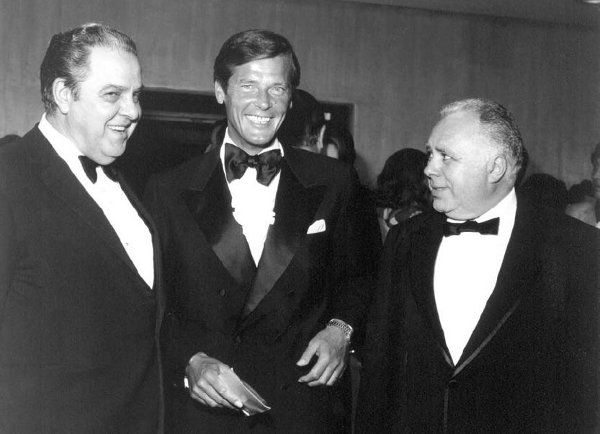
Here I am at the premiere of
Live And Let Die
with my benevolent producers.
Life was pretty good, and very busy. Cubby and Harry were busy doing their thing too, and while we stayed in touch, when they regrouped I became ‘unavailable’ due to my own filming commitments, and so they made Jimmy Bond an Australian, albeit for one adventure only.
Only after Sean returned for – and said ‘never again’ following –
Diamonds Are Forever
, in 1971, was I brought back into the frame and, happily, I was between acting gigs.
‘Are you alone?’ Harry asked when he called me long distance at my Denham home (my phone number, oddly enough, was Denham 2007). ‘You mustn’t talk about this,’ he added, ‘but Cubby agrees with my thinking in terms of you for the next Bond.’
I didn’t say anything to anyone. Once bitten, twice shy.
Contracts were drawn up and duly signed. It was a few weeks before Harry called again, to say he and Cubby felt I was ‘too fat’ and my hair was ‘too long’. I said I’d get a haircut and take the weight off.
I told my dear friend Lew Grade (who along with
The Saint
also bankrolled
The Persuaders!
) that I was to be the next 007. With tears welling in his eyes, he shook his head and said, ‘Roger, don’t do it. It’ll ruin your career!’
‘What career?’ I hear you say.
There is always a huge challenge associated with taking over a role from another actor, particularly when he has enjoyed great success in said role. I knew I’d face comparisons and wondered if I’d even be accepted by audiences. However, I consoled myself by thinking about the hundreds of actors who have all played Hamlet. Besides, if it didn’t work out I could always go back to modelling sweaters and gorging myself on more Flemingesque lunches in Venice, while letting my hair grow down my back.
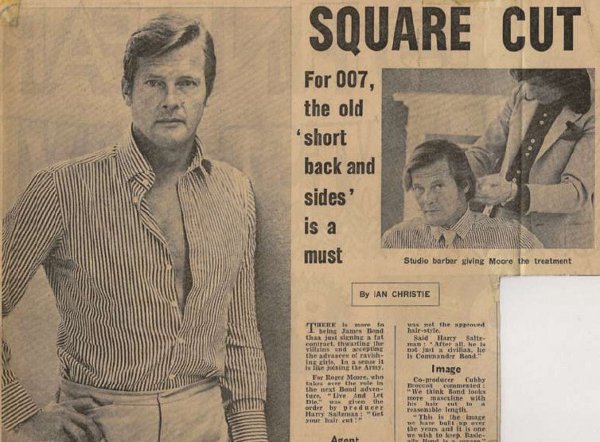
It’s not every day my getting a haircut made the newspapers.
At the outset, I knew I would have to be tougher than the other screen heroes I had played: Beau Maverick, Ivanhoe, Simon Templar and Brett Sinclair. However, having known many soldiers and servicemen, I didn’t necessarily believe that Bond was a man who enjoyed killing. He’d have to be rather sadistic to get a kick out of it. In fact, when I re-read the Fleming novels there was a line that stated, ‘Bond did not particularly enjoy killing’. And that was the key to my interpretation of the role: I wouldn’t enjoy killing, but I’d do it professionally, quickly and accurately.
What else? Well, Fleming made it clear Bond enjoyed the finer things in life from food, drink, cars and travel to, ahem, women. That’s not a bad job description, is it?
But what of Bond the man? Ian Fleming gave very little away about the character until he penned an obituary for Bond. Had the author not been persuaded otherwise by his publisher, the obituary would have come a lot sooner than it actually did. After just four books, feeling he’d done his duty and his adventures had run their course, Fleming grew tired of his hero, much as Arthur Conan Doyle had done with Sherlock Holmes. He fully intended to have Bond murdered at the end of
From Russia With Love
. Thankfully, he was talked out of it and continued the series. The memorial piece was reserved until
You Only Live Twice
was published (six novels later) – and was written by 007’s boss, M.
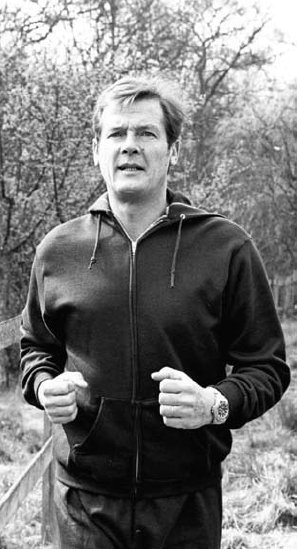
Having lost some hair, I was now trying to get fit and lose some weight – at my family home in Denham.
‘Commander James Bond, CMG, RNVR,’ it started, referring to Bond’s naval service and his being a Companion in the Order of St Michael and St George, ‘was born to Andrew Bond, of Glencoe, Scotland, and Monique Delacroix, from the Canton de Vaud, in south west Switzerland.’
Andrew Bond was a foreign representative of the Vickers armaments firm, and Jimmy travelled with his parents wherever their work took them. When Jimmy was but a mere eleven years of age, both parents were killed in a climbing accident in the Aiguilles Rouges, France.
Jimmy was an orphan. Poor Jimmy.
Bond’s early education was undertaken abroad and so he became fluent in both French and German. After his parents’ deaths, young Jim went to live with his aunt, Miss Charmian Bond, in Pett Bottom, a hamlet near Canterbury, Kent.
Then, Fleming revealed, aged twelve our young hero was entered at Eton College, but after a year there was ‘some alleged trouble with one of the boys’ maids’ and he was transferred to Fettes College in Edinburgh, where he took part in wrestling, founded a judo class and graduated early at the age of seventeen.
As for me, at seventeen I’d left school, been fired from my first job (not through problems with any maids, I might add) and was wondering what I would do with my future. Unlike Jimmy, I was not recruited by the special branch of the Royal Navy Volunteer Reserve, nor, a few years later, was I approached by MI6.
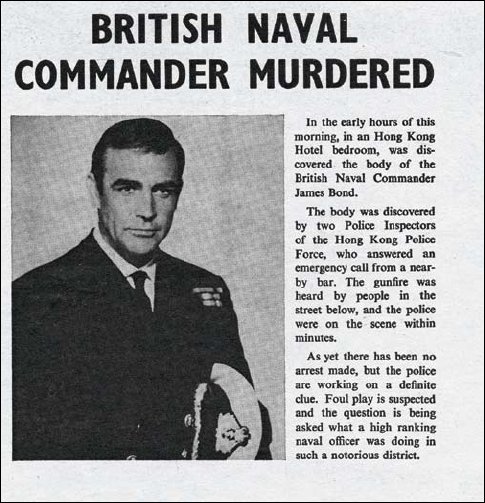
Bond’s demise was reported in
You Only Live Twice
on the front page of a newspaper.
Thankfully, the obituary was a ruse to put off Jimmy’s pursuers. He wasn’t dead, but it proved a helpful ploy in the adventure. It also proved helpful to us readers in stitching together a backcloth to the character. I’ve never been guilty of method acting – or even acting, if you want to argue a point – but doing this bit of background reading in
You Only Live Twice
gave me a few ideas about the character and why he was who he was. But throughout I kept thinking about that line ‘James Bond did not particularly enjoy killing’. That was the key.
Sean Connery had enjoyed huge success as the first filmic Bond. When
Dr. No
first hit the screens in 1962, in my humble opinion, where leading heroic parts were concerned, Sean changed everything. The world of Bond blew a hurricane breath of fresh air into the adventure-movie genre with its larger-than-life villains, even more evil than Satan himself; drop-dead-gorgeous girls who in fact did often drop dead if they found their way to Bond’s bed in the first half-hour of the film; hugely glamorous locations and sets; and a hero who was impeccably turned out, with the best taste in everything and the enviable ability to disrobe a leading lady in the flick of a camera shutter.
In an era when travel was the reserve of the rich, post-war rationing and rebuilding was still a vivid memory, and fine living consisted of a night out at the pictures followed by a fish-and-chip supper, James Bond offered something exciting – something previously unimaginable. Bond swiftly became a phenomenon.
But, as with all success stories, it very nearly wasn’t.
Harry Saltzman had an option on the books, which was fast running out. Columbia Pictures had turned it down, as had other potential backers. It was through partnering with Cubby Broccoli, and Cubby’s friendship with Arthur Krim at United Artists, that the series was eventually launched.
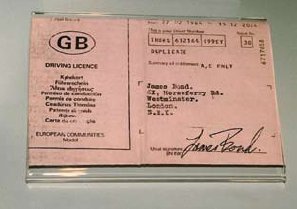
Although relatively few details are known about Jimmy’s home life, he did have a driving licence for one of the films. Westminster? Hmmm. I thought he lived in Chelsea.
A deal was struck with Krim and the fact that Cubby was able to loan Harry the airfare to get to New York and sign the deal saw the making not only of a great franchise, but also of a brilliant Scottish actor’s career, as well as fairly regular employment not only for Bonds but the villainous characters, glamorous girls, extras willing to fall off bridges and stuntmen keen to be hurled into the air by explosions and dive into shark-infested pools. The screenplay was co-written by Richard Maibaum, who went on to collaborate on twelve more of Jim’s adventures.
It is well documented that the first James Bond film was given a $1 million budget – and even for 1962, that was considered tight. Thankfully, it increased exponentially film by film, not least to accommodate my fee …The future of the franchise was very squarely dropped at my feet in 1972. I was to be the first English actor to play 007, and quite possibly the last if I ballsed it up.
So how do you follow someone as hugely popular as Sean? I hear you ask. Well, I was conscious I should at least not speak with a Scottish accent, and after discussions with director Guy Hamilton it was decided I would never order a vodka Martini, neither shaken nor stirred, nor would I drive an Aston Martin. They were too closely associated with Sean. I had to be the same, but different.
Of course, I watched Sean’s films again, and while not speaking directly with him about the part – after all, would I have called Larry Olivier and asked him about playing Hamlet had I been offered it? – being a friend of his I knew why he quit the role, and remember his declaring he’d ‘created a monster’. Sean wanted to distance himself from 007 and the associated hysteria and potential typecasting, to tackle other acting roles. I, on the other hand, was just grateful for a job.
Oh, and I should not forget George Lazenby, who had one shot at playing Jim in
On Her Majesty’s Secret Service
in 1969. By his own admission George was not an actor. He was a car salesman who began modelling and then slid sideways into acting work. His good looks and ability to throw a punch, coupled with his arrogance, secured him the part. I got to know him later on and, with hindsight, he admitted he had made a huge mistake in not signing on for seven movies, as originally offered, and parachuting out after just one on the advice of his friend-cum-manager Ronan O’Rahilly, who stated, ‘Bond is Connery’s gig. Make one and get out.’ The irony is, George is probably never going to be able to shake Bond off.
